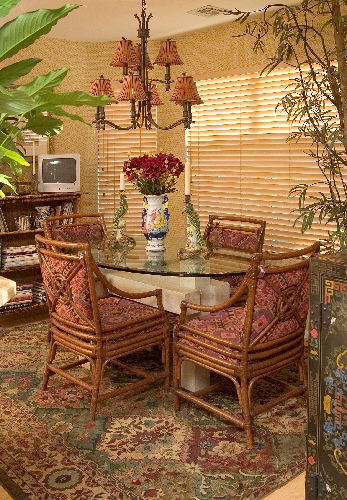British Colonial style has well-traveled look
Bali Ha'i, a mythical island where you could find "your own special love," captured the world's imagination through the brilliance of Rodgers and Hammerstein's production of "South Pacific." And, in a manner of speaking, I, too, found a special love in a design style that's referred to as British Colonial while working on a real Pacific island.
It's a style that's been an integral part of design for at least the last 150 years or so, and one whose elements I've certainly used now and again for years, but never gave much thought as to its origin. That was up until the time I had occasion, along with my wife, designer Barbara Woolf, to furnish a home at the 850-foot level in Kona on the big island of Hawaii.
The clients were downsizing from their Thai-style oceanfront home (also on the island) and wanted their new bit of heaven to simulate a lodge-style home, similar to the one in Isak Dinesen's "Out of Africa." To accomplish the task we took off for Bangkok and Chang Mai, Thailand, to shop and design custom furniture much as we had done for their last home.
What's so interesting is that, at the time, I had no idea that many of the pieces would be in the British Colonial style because, like so many other people, I didn't really have a definite idea of just what this style was -- despite the fact that we've all been surrounded by it in our homes for years.
That's because, simply put, the British Colonial style brings together a wide range of design elements and furnishings from the West Indies to the Far East to India and even Hong Kong by virtue of the fact that when the British Empire was at its peak about 150 years ago and had colonized a large part of the world, Asian and African motifs were adapted into traditional solid and sturdy furniture designs from back home.
Most times, out of necessity, they'd use woods such as teak and mahogany that were particularly suited to the humid climates of the tropics. Along with these ever-popular materials was a great range of other elements that have found there way into our everyday lives without us ever realizing from whence they originally came. It's this combination of East meeting West that defines the style and is characterized by some basics familiar to most of us.
To begin with, since the local craftsmen were not as highly trained as the ones back home, designs were simplified and less ornate than traditional English furniture. Still, they added some local color and flair to their work with things such as a carved pineapple atop the posts of a mahogany bed, for example. And the cozy looking plantation chair with its low seat, sloping back and scrolled arms has almost single-handedly come to symbolize a more laid back and less structured lifestyle.
Wood was often replaced with cane, wicker and bamboo on chairs, tables, sofas and beds to give rooms a lighter and more airy feeling, with the walls often painted with bright colors such as coral or cobalt blue. (Although we used mostly yellow on the walls in the Kona house.)
With this style you'll seldom, if ever, find heavy fabrics, such as chenille, or oversized furniture. Slipcovers are often used and tribal designs such as kilims, sisal, reed as well as animal skin rugs form an integral part of the style. Lighter cottons and linens are the preferred choice for upholstery and fabrics, and their design is both practical, exotic and emphasize the use of muted colors. (Though in the Kona house we opted for some strikingly beautiful, yet bold colors.) Animal prints, Indian sari fabrics and even realistic botanical prints can often be added to the mix. And there's more, much more.
Shutters to keep out the hot midday sun and ceiling fans with wide, rattan fanlike blades that helped to decorate as well as cool plantation rooms are all with us today. Other elements include mosquito netting draped around beds for a fun touch (we used cotton in Kona) and bamboo shades for covering windows. All were and remain a part of the British Colonial style. And what designer worth his salt hasn't included large potted plants such as ferns and palms as well as orchids in his design(s) at some point in order to help bring the beauty of the African and Asian landscapes inside just like the English settlers must have done so many years ago.
British Colonial furniture is a great complement to both traditional and transitional furniture designs and that's what keeps it relevant to this day. Adding elements of this style to your home not only brings an air of romance and sophistication to the overall design, but will make you feel as though you've traveled around the world collecting without ever having really left home at all.
Stephen Leon is a licensed interior designer and president of Soleil Design International; he has been designing and manufacturing custom furniture and cabinetry for more than 25 years. He has served on the board of directors of the Central California/Nevada Chapter of the American Society of Interior Designers and is a certified professional in green residential design. Questions can be sent to stephen@soleildesigninter
national.com.


















